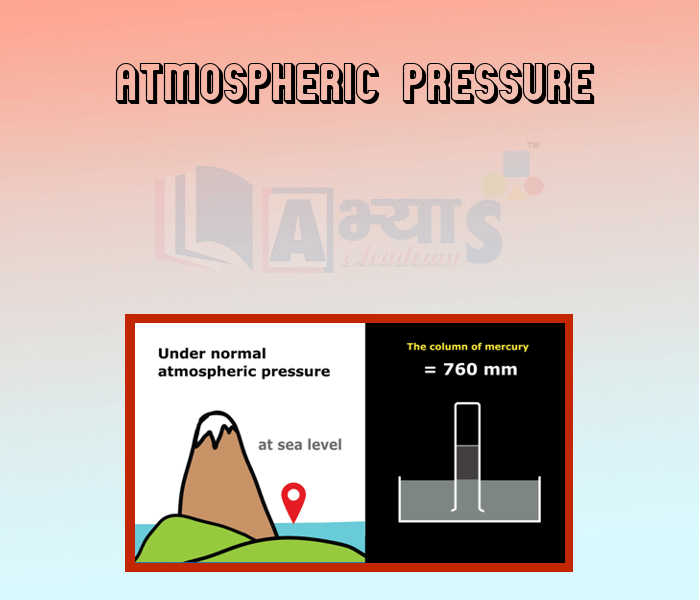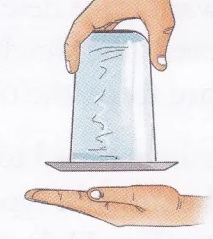Atmospheric Pressure





Atmospheric Pressure
Atmospheric pressure is defined as the pressure exerted on an object by the weight of the air above it. The atmospheric pressure on the Earths surface at sea level is about one hundred thousand pascal, i.e., 100 kPa.
| Measuring atmospheric pressure: An instrument called barometer is used to measure atmospheric pressure. It consists of long and thin tube filled with mercury and closed at one end. The open end of the tube is placed in a small trough full of mercury. The pressure exerted by air on the mercury of trough is able to hold certain height of the mercury column. When the air pressure is low, the mercury will move down, and when the air pressure increases the height of the mercury column increases. We can measure the pressure by the weight of mercury column in mm of Hg. Note: At sea level, the atmospheric pressure is 760 mm of Hg and is taken to be equal to 1 atmospheric pressure, i.e., 760 mm of Hg = atmospheric pressure at sea level. |  |
Variation of Atmospheric Pressure:
Aim: To show the presence of atmospheric pressure. Materials needed: A glass tumbler (with a smooth edge at the mouth, and withour a rim), a piece of stiff cardboard ( a little bigger than the mouth of the tumbler), and water. (It would be convenient to perform this activity over a wash basin or the kitchen sink.) Method: Observation: You will observe that the cardboard piece will not fall. Conclusion: Atmospheric pressure provides enough force to support a full glass of water. |  |
Which of the following are correct : (a) The pressure of the atmosphere is not uniform. (b) The pressure of the atmosphere is uniform. (c) Atmospheric pressure is measured by barometer. | |||
| Right Option : C | |||
| View Explanation | |||
Which of the following are correct : (a) The atmospheric pressure changes from place to place time to time. (b) The density of moist air is less than that of dry air. (c) Atmospheric pressure is defined as the pressure exerted on an object by the weight of the air above it. | |||
| Right Option : D | |||
| View Explanation | |||
The pressure exerted by a liquid: | |||
| Right Option : A | |||
| View Explanation |
Students / Parents Reviews [20]
Abhyas academy is great place to learn. I have learnt a lot here they have finished my fear of not answering.It has created a habit of self studying in me.The teachers here are very supportive and helpful. Earlier my maths and science was good but now it has been much better than before.

Barkha Arora
10thIn terms of methodology I want to say that institute provides expert guidence and results oriented monitering supplements by requsite study material along with regular tests which help the students to improve their education skills.The techniques of providing education helps the students to asses...

Aman Kumar Shrivastava
10thAbhyas is good institution and a innovative institute also. It is a good platform of beginners.Due to Abhyas,he has got knoweledge about reasoning and confidence.My son has improved his vocabulary because of Abhyas.Teacher have very friendly atmosphere also.

Manish Kumar
10thOne of the best institutes to develope a child interest in studies.Provides SST and English knowledge also unlike other institutes. Teachers are co operative and friendly online tests andPPT develope practical knowledge also.

Aman Kumar Shrivastava
10thA marvelous experience with Abhyas. I am glad to share that my ward has achieved more than enough at the Ambala ABHYAS centre. Years have passed on and more and more he has gained. May the centre flourish and develop day by day by the grace of God.

Archit Segal
7thAbhyas Methodology is very good. It is based on according to student and each child manages accordingly to its properly. Methodology has improved the abilities of students to shine them in future.

Manish Kumar
10thIt has a great methodology. Students here can get analysis to their test quickly.We can learn easily through PPTs and the testing methods are good. We know that where we have to practice

Barkha Arora
10thAbout Abhyas metholodology the teachers are very nice and hardworking toward students.The Centre Head Mrs Anu Sethi is also a brilliant teacher.Abhyas has taught me how to overcome problems and has always taken my doubts and suppoeted me.

Shreya Shrivastava
8thI have spent a wonderful time in Abhyas academy. It has made my reasoning more apt, English more stronger and Maths an interesting subject for me. It has given me a habbit of self studying

Yatharthi Sharma
10thThird consective year,my ward is in Abhyas with nice experience of admin and transport support.Educational standard of the institute recumbent at satisfactory level. One thing would live to bring in notice that last year study books was distributed after half of the session was over,though study ...

Ayan Ghosh
8thThe experience was nice. I studied here for three years and saw a tremendous change in myself. I started liking subjects like English and SST which earlier I ran from. Extra knowledge gave me confidence to overcome competitive exams. One of the best institutes for secondary education.

Aman Kumar Shrivastava
10thMy experience with Abhyas Academy has been very good. When I was not in Abhyas whenever teacher ask questions I could not speak it confidently but when I came in Abhyas, my speaking skills developed and now I am the first one to give the answer of teachers question.

Upmanyu Sharma
7thAbhyas institute is one of the best coaching institute in the vicinity of Ambala Cantt area. The teachers of the institute are well experienced and very helpful in solving the problems of the students.The good thing of the institute is that it is providing extra classes for the students who are w...

Aman Kumar Shrivastava
10thMy experience with Abhyas academy is very good. I did not think that my every subject coming here will be so strong. The main thing is that the online tests had made me learn here more things.

Hiya Gupta
8thAbhyas is an institute of high repute. Yogansh has taken admission last year. It creates abilities in child to prepare for competitive exams. Students are motivated by living prizes on basis of performance in Abhyas exams. He is satisfied with institute.

Yogansh Nyasi
7thBeing a parent, I saw my daughter improvement in her studies by seeing a good result in all day to day compititive exam TMO, NSO, IEO etc and as well as studies. I have got a fruitful result from my daughter.

Prisha Gupta
8thIt was good as the experience because as we had come here we had been improved in a such envirnment created here.Extra is taught which is beneficial for future.

Eshan Arora
8thMy experience with Abhyas academy is very nice or it can be said wonderful. I have been studying here from seven class. I have been completing my journey of three years. I am tinking that I should join Abhyas Academy in tenth class as I am seeing much improvement in Maths and English

Hridey Preet
9thWhen I have not joined Abhyas Academy, my skills of solving maths problems were not clear. But, after joining it, my skills have been developed and my concepts of science and SST are very well. I also came to know about other subjects such as vedic maths and reasoning.

Sharandeep Singh
7thMy experience was very good with Abhyas academy. I am studying here from 6th class and I am satisfied by its results in my life. I improved a lot here ahead of school syllabus.
